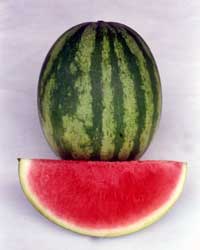Watermelon – Growers’ Guide

Season
Can be planted in all tropical season, sun light full day, temperature 20-35 C for growth, temperature 18-25 C for breeding.
Soil
Loam, Clay loam, good irrigation loam, pH 5-5.6. To plough the soil with dry sun 7-10 days. To plough the soil deep 15-20 cm. [ V shape]. Additional manure rate 1-1.5 ton / rai + Chemical fertilizer 15-15-15 rate 50 Kg./rai + Furadan 3 G 2-3 Kg/rai + caborac 1-2 Kg/rai soil to cover up plot wide 80 cm. high 30 cm. 2 row/ plot [ plot wide total 5-6 m.]. Use plastic or straw to cover up step end.
Agriculture
Transplanting sprout 12-15 days or real leaf 2-3, open water in to plot, perforate on plastic space 70- 80 cm. Cultivate Seeds seed soak in clean water 4-6 hour, cover with cotton keep temperature 28-30 C long 24-32 hour untill the seed have root 0.5 cm. and planted in plastic bag Plastic bag for seedling size 4×4″ pierce hole that under irrigation soil loam 3 / manure 1/ fertilizer 0-46-0 50 gm. Mix in to bag Select branch and fruit water melon after plated 25-30 days. first flower cut will select second fruit and next fruit because good quality Fertilizer 1. With plough Fertilizer 15-15-15 rate 50 Kg./rai 2. After transplant 5- 7 days Fertilizer 21-0-0 rate 2-3 gm./plant 3.After transplant 20-25 days Fertilizer 15-15-15 rate 20- 25 Kg./rai after fruit same egg 4.
Before harvesting 2-3 weeks Fertilizer 13-13-21 rate 20-25 Kg. / Rai.
Disease
Anthracnose Downy Mildew spray Mancozap+Matacllic coper Wilt use variety resistance change area Virus pull plant burn
Insect: Thirps spray Cabofuran, Beetles spray Dicrotophos or Cabaril. Aprid spray Monocrotophos
Maturity
60-80 days. Characteristics of watermelon that can be harvested. Fruit maturity have dark color but young fruit have light color. Skin that touch gourd will change yellow.
The history of watermelons is a long one; there is a Sanskrit word for watermelon, and fruits are depicted by early Egyptian artists, indicating an antiquity in agriculture of more than 4,000 years.
Watermelon contains vitamin A and some vitamin C. It is usually eaten raw. The rind is sometimes preserved as a pickle.
